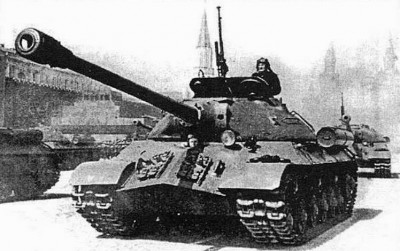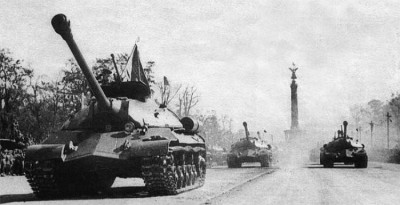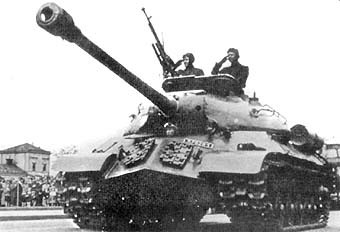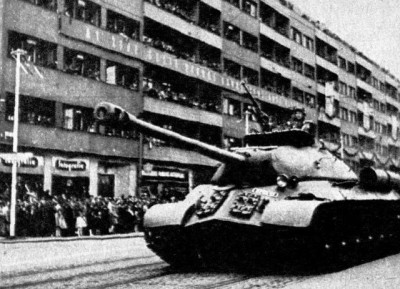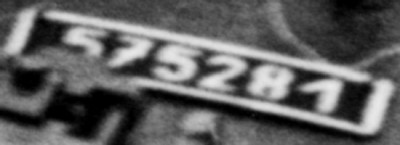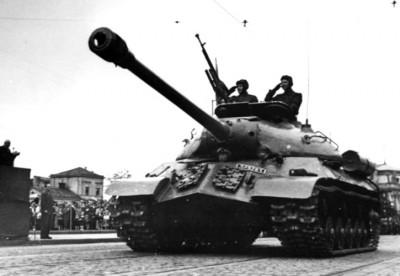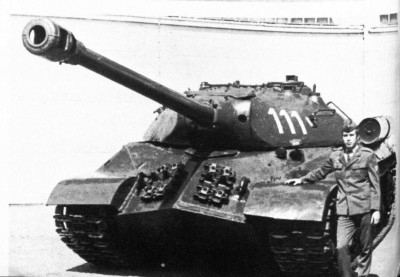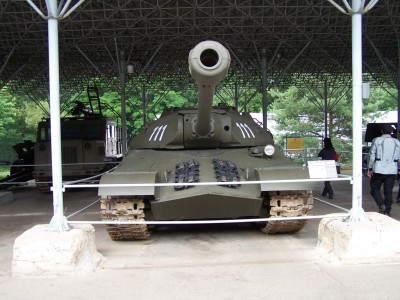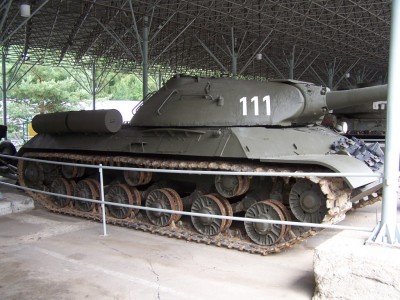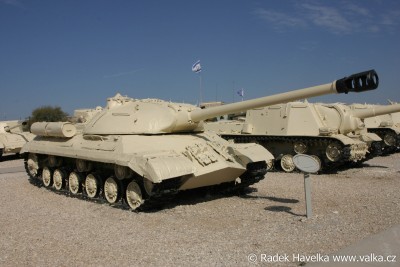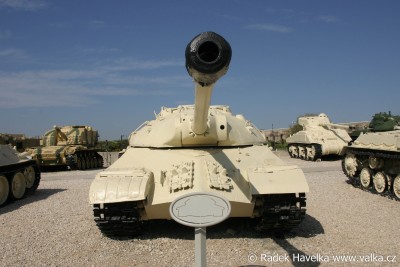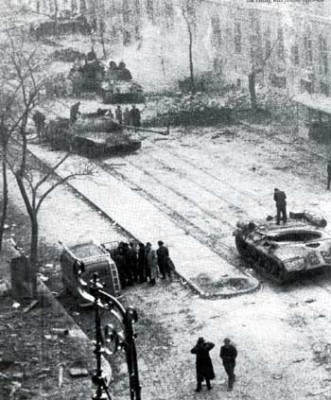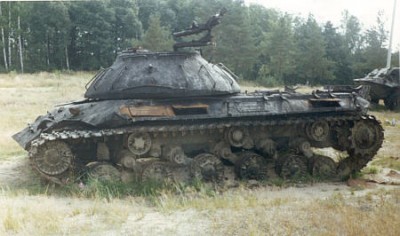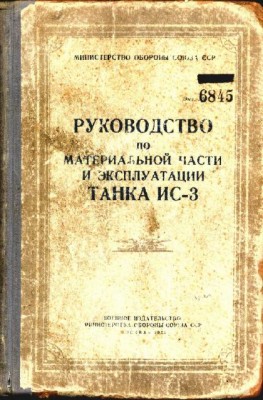| Název: Name: | IS-3 | IS-3 |
| Originální název: Original Name: | ИС-3 | |
| Kategorie: Category: | těžký tank | heavy tank |
| Výrobce: Producer: | DD.05.1945-DD.07.1946 Čeljabinský Kirovův závod, Čeljabinsk | |
| Období výroby: Production Period: | DD.05.1945-DD.07.1946 | |
| Vyrobeno kusů: Number of Produced: | 2311 | |
| Prototyp vyroben: Prototype Built: | DD.MM.1944 | |
| Osádka: Crew: | 4 | |
| Technické údaje: Technical Data: | ||
| Bojová hmotnost: Combat Weight: | 46500 kg | 102515 lb |
| Délka s kanónem dopředu: Length with Gun Forward: | 9850 mm | 32 ft 3 ¾ in |
| Délka korby: Hull Length: | 6900 mm | 22 ft 7 ⅝ in |
| Celková šířka: Overall Width: | 3150 mm | 10 ft 4 in |
| Celková výška: Overall Height: | 2450 mm | 8 ft ½ in |
| Světlá výška: Ground Clearance: | 465 mm | 1 ft 6 ¼ in |
| Šířka pásu: Track Width: | 650 mm | 2 ft 1 ⅝ in |
| Měrný tlak: Ground Pressure: | 0.0853 MPa | 12.37 psi |
| Pancéřování: Armour: | Korba : zepředu: 110 mm / 43°, 56°, 63°, 72° bok: 90 mm / 0-60° zezadu: 60 mm / 41°, 48° shora: 20 mm zespodu: 20 mm Věž: zepředu: 250 mm / ?° bok: 110-220 mm / 0-60° zezadu: 110-220 mm / 0-60° shora: 20 mm | Hull: front: 4.3 in / 43°, 56°, 63°, 72° side: 3.5 in / 0-60 rear: 2.4 in / 41°, 48 top: 0.8 in bottom: 0.8 in Turret: front: 9.8 in / ?° side: 4.3-8.7 in / 0-60° rear: 4.3-8.7 in / 0-60° top: 0.8 in |
| Pohon: Propulsion: | ||
| Typ: Type: | V-11-IS-3 - vznětový, vidlicový - počet válců: 12 | V-11-IS-3 - diesel, V-type - number of cylinders: 12 |
| Výkon: Power: | 382,5 kW při 2000 ot/min | 512.9 bhp at 2000 rpm |
| Převodové ústrojí: Transmission: | 4+1 | 4+1 |
| Výkony: Performance: | ||
| Rychlost na silnici: Road Speed: | 40 km/h | 25 mph |
| Rychlost v terénu: Cross-country Speed: | 20 km/h | 12 mph |
| Jízdní dosah po silnici: Cruising Range on Road: | 185 km | 115 mi |
| Jízdní dosah v terénu: Cross-country Cruising Range: | ? km | ? mi |
| Překonávání překážek: Obstacles Crossing: | ||
| Svah: Gradient: | 32 ° | 71 % |
| Boční náklon: Side Slope: | 30 ° | 67 % |
| Překročivost: Trench Crossing: | 2,5 m | 98 in |
| Výstupnost: Vertical Obstacle: | 1 m | 39 in |
| Brodivost: Fording Depth: | 1,4 m | 55 in |
| Výzbroj: Armament: | ||
| Hlavní: Main: | 122mm kanon D-25T - 28 nábojů | 122 mm gun D-25T - 28 rounds |
| Vedlejší: Secondary: | 1x 7,62mm kulomet DT (1000 nábojů) 1x 12,7mm kulomet DŠK (945 nábojů) | 1x 7,62 mm machine gun DT (1000 rounds) 1x 12,7 mm machine gun DShK (945 rounds) |
| Uživatelské státy: User States: | | |
| Poznámka: Note: | - | - |
| Zdroje: Sources: | - | |
IS-3
ИС-3
One more thing about the deployment, or rather non-deployment, of IS-3 machines in the DSV battles. As I wrote earlier the test machines left the factory in May 1945! Even if this had happened on the first day of the month, just transport to the initial position, anywhere on the Western Front, would have taken several days. Which is not to be expected, because the Soviet Army had enough heavy tanks and therefore preferred the Kubinka test site to the risky combat tests.
I assume the Soviets abandoned combat trials against the Japanese for the same reason. Moreover, the East Asian military area did not offer an opponent equipped with comparable means, and the local difficult terrain could be successfully replaced by identical terrain conditions in a more technically advanced area of the Soviet Union.
The Berlin show of 52 IS-3 tanks in 1945, was a classic show of force against the Western Allies. It can be assumed that these were all operational pre-production and first production machines. My comment above about the complexity of transport to the west indirectly proves why these machines did not take part in the two Moscow parades in 1945.
Source of the attached photos - unknown Russian website.
Moskevská přehlídka v roce 1946.
Berlínská přehlídka v roce 1945.
I assume the Soviets abandoned combat trials against the Japanese for the same reason. Moreover, the East Asian military area did not offer an opponent equipped with comparable means, and the local difficult terrain could be successfully replaced by identical terrain conditions in a more technically advanced area of the Soviet Union.
The Berlin show of 52 IS-3 tanks in 1945, was a classic show of force against the Western Allies. It can be assumed that these were all operational pre-production and first production machines. My comment above about the complexity of transport to the west indirectly proves why these machines did not take part in the two Moscow parades in 1945.
Source of the attached photos - unknown Russian website.
| Period | - |
| Type | - |
| Camouflage | - |
| Country | - |
| Production No. | - |
| Poznávací značka / evidenční číslo | - |
| Tactical marking | - |
| Name | - |
| Unit | - |
| Date (DD.MM.RRRR) | - |
| Author | - |
| Print size / 300 DPI | - |
| Published with authors permit | - |
| Author Website | - |
Moskevská přehlídka v roce 1946.
| Period | - |
| Type | - |
| Camouflage | - |
| Country | - |
| Production No. | - |
| Poznávací značka / evidenční číslo | - |
| Tactical marking | - |
| Name | - |
| Unit | - |
| Date (DD.MM.RRRR) | - |
| Author | - |
| Print size / 300 DPI | - |
| Published with authors permit | - |
| Author Website | - |
Berlínská přehlídka v roce 1945.
Reklama
IS-3 in the Czechoslovak army
On July 18, 1947, a pair of IS-3 tanks was delivered to the Tank Training School, where they were put through their paces. The Army has shown a desire to provide the necessary number of this tank for the planned formation of a heavy tank regiment.
In 1950, from the base of Tank Regiment 1, whose armament consisted of useful German equipment (T-40/45), the Strašice 1st Heavy Tank Regiment was formed. Efforts to arm this regiment with 51 IS-3s (peacetime status) or 58 (according to war tables) came to naught. The pair of IS-3 tanks delivered served only for military parade purposes.
After the disbandment of the 1st Heavy Tank Regiment in 1956, the tanks were stored at tank bases. Tank number 67466 was given to the Antonín Zápotocký Military Academy in Brno as a training aid. In 1968, the Military Historical Institute in Prague acquired it for its collections. Today this tank is restored in a mobile state and forms part of the collections of the Military Technical Museum in Lesany. The fate of the second IS-3 tank is unknown to me.
As of 8/1958, one IS-3 was registered in the state of the 2nd Tank Base in Žilina.
Note on the photo from the tour:
The IS-3 from the May tour (9 May 1954) is driven by the personal driver, Lt. Emil Svozil. In the tower used to be the detached commander of the tank and mechanized troops, Lt. Gen. V. Janko. The second machine was operated by František Masopust. In it rode the chief of staff Hero of the USSR Col. R. Tesařík along with a battle flag. I don't know what year this memoir is from.
On July 18, 1947, a pair of IS-3 tanks was delivered to the Tank Training School, where they were put through their paces. The Army has shown a desire to provide the necessary number of this tank for the planned formation of a heavy tank regiment.
In 1950, from the base of Tank Regiment 1, whose armament consisted of useful German equipment (T-40/45), the Strašice 1st Heavy Tank Regiment was formed. Efforts to arm this regiment with 51 IS-3s (peacetime status) or 58 (according to war tables) came to naught. The pair of IS-3 tanks delivered served only for military parade purposes.
After the disbandment of the 1st Heavy Tank Regiment in 1956, the tanks were stored at tank bases. Tank number 67466 was given to the Antonín Zápotocký Military Academy in Brno as a training aid. In 1968, the Military Historical Institute in Prague acquired it for its collections. Today this tank is restored in a mobile state and forms part of the collections of the Military Technical Museum in Lesany. The fate of the second IS-3 tank is unknown to me.
As of 8/1958, one IS-3 was registered in the state of the 2nd Tank Base in Žilina.
Note on the photo from the tour:
The IS-3 from the May tour (9 May 1954) is driven by the personal driver, Lt. Emil Svozil. In the tower used to be the detached commander of the tank and mechanized troops, Lt. Gen. V. Janko. The second machine was operated by František Masopust. In it rode the chief of staff Hero of the USSR Col. R. Tesařík along with a battle flag. I don't know what year this memoir is from.
V.Francev, M. Kopecký - Soviet Armoured Vehicles in the Armament of the Czechoslovak Army 1943-1951, Capricorn publications, year of publication 2018, ISBN 978-80-87578-19-3
Pavel Minařík : http://vojenstvi.kvalitne.cz/vasedotazy_9.htm
article from the 1984 Notebook - Confessions of a Retired Tanker
| Period | - |
| Type | - |
| Camouflage | - |
| Country | - |
| Production No. | - |
| Poznávací značka / evidenční číslo | - |
| Tactical marking | - |
| Name | - |
| Unit | - |
| Date (DD.MM.RRRR) | DD.MM.RRRR |
| Author | - |
| Print size / 300 DPI | - |
| Published with authors permit | - |
| Author Website | - |
To : Mr. Tintera.
I am writing to you to ask if you have been able to identify the number composition of the number plates on the IS-3 heavy tank, at the military parade in Prague , 9 May 1954. The tank was carrying the commander of the tank troops, Gen. Vladimir Jank. Of course, it was a ČB ŠPZ - which is well known to you.
Source : " Confessions of a retired tank driver " - RECORD 1984
Veliteľ tankových a mechanizovaných vojsk, gen. Vladimír JANKO.
I am writing to you to ask if you have been able to identify the number composition of the number plates on the IS-3 heavy tank, at the military parade in Prague , 9 May 1954. The tank was carrying the commander of the tank troops, Gen. Vladimir Jank. Of course, it was a ČB ŠPZ - which is well known to you.
Source : " Confessions of a retired tank driver " - RECORD 1984
| Period | - |
| Type | - |
| Camouflage | - |
| Country | - |
| Production No. | - |
| Poznávací značka / evidenční číslo | - |
| Tactical marking | - |
| Name | - |
| Unit | - |
| Date (DD.MM.RRRR) | - |
| Author | - |
| Print size / 300 DPI | - |
| Published with authors permit | - |
| Author Website | - |
Veliteľ tankových a mechanizovaných vojsk, gen. Vladimír JANKO.
18.07.1947 came dvojica povojnových ťažkých machines IS-3, ako model cars pre planned ťažký tank regiment. In his state of the ich received HERE under registration no. 67465 ( item no. no To the 100549) and 67466 ( no hull 604A-66) ....
Source :" Sovietske an armor vozidlá vo arsenal československej army 1943-1951" In.Francev, M. Kopecky ISBN 978-80-87578-19-3 - CAPRICORN PUBLICATIONS - 2018.
Source :" Sovietske an armor vozidlá vo arsenal československej army 1943-1951" In.Francev, M. Kopecky ISBN 978-80-87578-19-3 - CAPRICORN PUBLICATIONS - 2018.
Reklama
Dear colleague,
I cannot identify this image at present because it is not in the collections of the Diffrology Club. Our club owns a similar picture, which was taken in Obránců míru Street (now Milady Horákové), probably near the railway station Prague-Dejvice, I do not know its crew or the date of taking.
P. S.
The published photograph titled: "IS-3 gen. Janko - driver Emil Svozil ..." I will try to search the collections of the Military Central Archive and identify the registration number of the vehicle.
Výřez z výše uvedené fotografie s vojenským evidenčním číslem: 575281
IS-3 na Obránců míru ...
I cannot identify this image at present because it is not in the collections of the Diffrology Club. Our club owns a similar picture, which was taken in Obránců míru Street (now Milady Horákové), probably near the railway station Prague-Dejvice, I do not know its crew or the date of taking.
P. S.
The published photograph titled: "IS-3 gen. Janko - driver Emil Svozil ..." I will try to search the collections of the Military Central Archive and identify the registration number of the vehicle.
| Period | - |
| Type | - |
| Camouflage | - |
| Country | - |
| Production No. | - |
| Poznávací značka / evidenční číslo | - |
| Tactical marking | - |
| Name | - |
| Unit | - |
| Date (DD.MM.RRRR) | - |
| Author | - |
| Print size / 300 DPI | - |
| Published with authors permit | - |
| Author Website | - |
Výřez z výše uvedené fotografie s vojenským evidenčním číslem: 575281
| Period | - |
| Type | - |
| Camouflage | - |
| Country | - |
| Production No. | - |
| Poznávací značka / evidenční číslo | - |
| Tactical marking | - |
| Name | - |
| Unit | - |
| Date (DD.MM.RRRR) | - |
| Author | - |
| Print size / 300 DPI | - |
| Published with authors permit | - |
| Author Website | - |
IS-3 na Obránců míru ...
To Mr. Tintera : First of all, thank you for identifying the number as well as for the very good photo of the tank of interest. I have so far possessed a lesser quality shot from a Russian website. I believe that you have sufficient potential knowledge and materials to be able to use these two different shots of the IS - 3 heavy tank, from two different locations, to refute or confirm the opinion about the existence of one or two pieces of this heavy tank in the CSLA's competence. Assuming they can identify the license plate number shown in my previous post. This issue has already been addressed somewhere but the outcome was not clear. Factually someone has confirmed the existence of two machines but a certain group is leaning towards the view of one machine. Also in the article I sent you as SZ, the author mentions two machines at the May 1954 Prague show. The first machine IS - 3 carried the commander of the tank and mechanized troops, Lt. Gen. JANEK and the second identical machine, HSZ, Col. TESAŘÍK with a battle flag.
Czechoslovak machine IS-3 after reconstruction in Military Repair Plant / Nový Jičín ? /. The machine is fully functional and is currently in the collections of the VHM Lešany.
The only preserved ŤSD-152 (ISU-152) has also undergone a similar overhaul at the same plant.
IS-3 po generálke vo VOP.
The only preserved ŤSD-152 (ISU-152) has also undergone a similar overhaul at the same plant.
ATOM 1975
| Period | - |
| Type | - |
| Camouflage | - |
| Country | - |
| Production No. | - |
| Poznávací značka / evidenční číslo | - |
| Tactical marking | - |
| Name | - |
| Unit | - |
| Date (DD.MM.RRRR) | DD.MM.RRRR |
| Author | - |
| Print size / 300 DPI | - |
| Published with authors permit | - |
| Author Website | - |
IS-3 po generálke vo VOP.
To otázke Miroslav sort of lumbering ohľadom identifikácie reg no on priloženej photo.
Vehicle of military prehliadky of 9.5.1953 on pražskej Letenskej plain nesie reg no 875613, well probably ide on kryciu evidenčnú tabuľku under that is the real evidenčné number. A similar camouflage was applied to ŤSD-152 is vysvetlená in the source uvedenom nižšie (page 98).
Interesting question, would a bolo, or mal tank still the same krycie reg. number, or mal every year some other.
Vehicle of military prehliadky of 9.5.1953 on pražskej Letenskej plain nesie reg no 875613, well probably ide on kryciu evidenčnú tabuľku under that is the real evidenčné number. A similar camouflage was applied to ŤSD-152 is vysvetlená in the source uvedenom nižšie (page 98).
Interesting question, would a bolo, or mal tank still the same krycie reg. number, or mal every year some other.
.Francev, M. Kopecky - Sovietske an armor vozidlá vo arsenal československej army 1943-1951, Capricorn publications, rok vydania 2018, page 96, ISBN 978-80-87578-19-3
.This post has not been translated to English yet. Please use the TRANSLATE button above to see machine translation of this post.
vlastní foto
| Period | - |
| Type | - |
| Camouflage | - |
| Country | - |
| Production No. | - |
| Poznávací značka / evidenční číslo | - |
| Tactical marking | - |
| Name | - |
| Unit | - |
| Date (DD.MM.RRRR) | DD.MM.RRRR |
| Author | - |
| Print size / 300 DPI | - |
| Published with authors permit | - |
| Author Website | - |
| Period | - |
| Type | - |
| Camouflage | - |
| Country | - |
| Production No. | - |
| Poznávací značka / evidenční číslo | - |
| Tactical marking | - |
| Name | - |
| Unit | - |
| Date (DD.MM.RRRR) | DD.MM.RRRR |
| Author | - |
| Print size / 300 DPI | - |
| Published with authors permit | - |
| Author Website | - |
the Monument and the museum of the Armored corps, Latrun
Ps. I don't know if in this case it is not a variant of the IS-3M, at least some parts of it clearly come ....
Ps. I don't know if in this case it is not a variant of the IS-3M, at least some parts of it clearly come ....
| Period | - |
| Type | IS-3 |
| Camouflage | - |
| Country | - |
| Production No. | - |
| Poznávací značka / evidenční číslo | - |
| Tactical marking | - |
| Name | - |
| Unit | - |
| Date (DD.MM.RRRR) | DD.MM.RRRR |
| Author | - |
| Print size / 300 DPI | - |
| Published with authors permit | - |
| Author Website | - |
| Period | - |
| Type | IS-3 |
| Camouflage | - |
| Country | - |
| Production No. | - |
| Poznávací značka / evidenční číslo | - |
| Tactical marking | - |
| Name | - |
| Unit | - |
| Date (DD.MM.RRRR) | DD.MM.RRRR |
| Author | - |
| Print size / 300 DPI | - |
| Published with authors permit | - |
| Author Website | - |
Soviet IS-3 tanks on the streets of Budapest during the suppression of the Hungarian uprising in October-November 1956.
| Period | - |
| Type | - |
| Camouflage | - |
| Country | - |
| Production No. | - |
| Poznávací značka / evidenční číslo | - |
| Tactical marking | - |
| Name | - |
| Unit | - |
| Date (DD.MM.RRRR) | DD.MM.RRRR |
| Author | - |
| Print size / 300 DPI | - |
| Published with authors permit | - |
| Author Website | - |
This post has not been translated to English yet. Please use the TRANSLATE button above to see machine translation of this post.
Zaniknuté internetové stránky
| Period | - |
| Type | - |
| Camouflage | - |
| Country | - |
| Production No. | - |
| Poznávací značka / evidenční číslo | - |
| Tactical marking | - |
| Name | - |
| Unit | - |
| Date (DD.MM.RRRR) | DD.MM.RRRR |
| Author | - |
| Print size / 300 DPI | - |
| Published with authors permit | - |
| Author Website | - |
| Period | - |
| Type | - |
| Camouflage | - |
| Country | - |
| Production No. | - |
| Poznávací značka / evidenční číslo | - |
| Tactical marking | - |
| Name | - |
| Unit | - |
| Date (DD.MM.RRRR) | DD.MM.RRRR |
| Author | - |
| Print size / 300 DPI | - |
| Published with authors permit | - |
| Author Website | - |
| Period | - |
| Type | - |
| Camouflage | - |
| Country | - |
| Production No. | - |
| Poznávací značka / evidenční číslo | - |
| Tactical marking | - |
| Name | - |
| Unit | - |
| Date (DD.MM.RRRR) | DD.MM.RRRR |
| Author | - |
| Print size / 300 DPI | - |
| Published with authors permit | - |
| Author Website | - |
Diskuse
Well, so yesterday I tried to get some information about the deployment of the IS-3, but all I found is that it is sometimes wrongly and unsubstantiated that it was first deployed during the capture of Berlin. The deployment of these tanks against the Japanese Kuantung army in August 1945 cannot be ruled out.
Otherwise, it was not really officially introduced until September 7, 1945 at a parade in Berlin (perhaps 52 units.
The prototype was supposed to have been built perhaps sometime in the autumn of 1944, and the first mass-produced tanks rolled off the lines about the spring of 1945, but there were not enough of them for combat deployment on the Western Front.
In total, something like 2,200-2,300 vehicles were to be produced from the spring of 1945 to the end of 1946.
Otherwise, it was not really officially introduced until September 7, 1945 at a parade in Berlin (perhaps 52 units.
The prototype was supposed to have been built perhaps sometime in the autumn of 1944, and the first mass-produced tanks rolled off the lines about the spring of 1945, but there were not enough of them for combat deployment on the Western Front.
In total, something like 2,200-2,300 vehicles were to be produced from the spring of 1945 to the end of 1946.
The Berlin deployment is a well-known rumor. The Far East...it is quite likely that the latest machines would have been sent to an "inferior" battlefield, at a time when they were better suited as a deterrent force in the fledgling "Iron Curtain". The older "war" types were just fine for that.
There is an interesting debate on axis regarding the deployment of the IS-3 in the last weeks of the war in Europe.Some more proficient Englishman could report it...
forum.axishistory.com
forum.axishistory.com
Late but still.
When looking for technical data of IS-3 I came across in one post by Bran on axis link where there was an interesting debate about the deployment of IS-3 in the last weeks of the war in Europe.
There was some interesting information which I would like to bring you closer.
The whole debate was quite extensive but I would like to review only the mentioned passage about the combat deployment of the IS-3 at the end of the war.
According to the contribution of the man who acted in the discussion as Igor from Moscow, at least two cases of combat deployment of the IS-3 were documented.
The first mention is from a book by Will Fey, a Waffen SS veteran, in an article by Miles Krogfus: Das Reich Panzers, San Diego USA
"...driven back south of Komaron during the third week of March 1945, "Das Reich" personnel claimed to have met the JS III for the first time in combat..."
"...retreating south of Komaron(?) during the third week of March 1945, "Das Reich" (crew) members claimed to have met the JS III for the first time in combat...."
Will Fey, Armor Battles of the Waffen SS, Stackpole Military Series, P.351."
From Christopher Duffy's book:
"... The JS-3, essentially a version of the JS-2 with redesigned and very heavily sloped armour, saw action in Germany in the final weeks of the war. A German testifies that 'our otherwise excellent L48 75-mm tank gun could do little against the super-heavy Russian Stalin tanks. Only what we called a "Sunday shot" was capable of penetrating that thick armour."
(Schlaufler, 1979, 26)
"...The JS-3, essentially a version of the Js-2 with redesigned and steeply sloping armor, saw combat service in Germany in the closing weeks of the war. The Germans testified that "our otherwise excellent L48 75-mm tank gun could not do much against Stalin's super-heavy Russian tanks. Only, as they say, a lucky shot was able to penetrate their thick armor."
Christopher Duffy, Red Storm on the Reich. The Soviet March on Germany, 1945, London, 2001, P. 322.
When looking for technical data of IS-3 I came across in one post by Bran on axis link where there was an interesting debate about the deployment of IS-3 in the last weeks of the war in Europe.
There was some interesting information which I would like to bring you closer.
The whole debate was quite extensive but I would like to review only the mentioned passage about the combat deployment of the IS-3 at the end of the war.
According to the contribution of the man who acted in the discussion as Igor from Moscow, at least two cases of combat deployment of the IS-3 were documented.
The first mention is from a book by Will Fey, a Waffen SS veteran, in an article by Miles Krogfus: Das Reich Panzers, San Diego USA
"...driven back south of Komaron during the third week of March 1945, "Das Reich" personnel claimed to have met the JS III for the first time in combat..."
"...retreating south of Komaron(?) during the third week of March 1945, "Das Reich" (crew) members claimed to have met the JS III for the first time in combat...."
Will Fey, Armor Battles of the Waffen SS, Stackpole Military Series, P.351."
From Christopher Duffy's book:
"... The JS-3, essentially a version of the JS-2 with redesigned and very heavily sloped armour, saw action in Germany in the final weeks of the war. A German testifies that 'our otherwise excellent L48 75-mm tank gun could do little against the super-heavy Russian Stalin tanks. Only what we called a "Sunday shot" was capable of penetrating that thick armour."
(Schlaufler, 1979, 26)
"...The JS-3, essentially a version of the Js-2 with redesigned and steeply sloping armor, saw combat service in Germany in the closing weeks of the war. The Germans testified that "our otherwise excellent L48 75-mm tank gun could not do much against Stalin's super-heavy Russian tanks. Only, as they say, a lucky shot was able to penetrate their thick armor."
Christopher Duffy, Red Storm on the Reich. The Soviet March on Germany, 1945, London, 2001, P. 322.
I don't really buy the Axis stories. Truth be told - the literature links look good and I use them myself often  . But still - memory is a mess and man is a sclerotic creature. So the memories of memorials, unsupported by other supporting documents ( contemporary photos, articles in the press...material evidence...) are often misleading. 4people connect 2 different events... 2 different things... and it's a historical bombshell. Fantasies (even unintentional
. But still - memory is a mess and man is a sclerotic creature. So the memories of memorials, unsupported by other supporting documents ( contemporary photos, articles in the press...material evidence...) are often misleading. 4people connect 2 different events... 2 different things... and it's a historical bombshell. Fantasies (even unintentional  ) can spin the facts nicely. So until I see a photo of the JS-3 in Berlin, I won't believe it. Just like until I see a photo of JS-3 in China or Mongolia fighting the Kwantung Army. I guess I've gotten too used to associating them with the postwar era
) can spin the facts nicely. So until I see a photo of the JS-3 in Berlin, I won't believe it. Just like until I see a photo of JS-3 in China or Mongolia fighting the Kwantung Army. I guess I've gotten too used to associating them with the postwar era  .
.
Dear,
je známa stručná informace z ruských zdroje v tomto znění: "... The first pilot batch of heavy tanks IS-3 left the factory workshops in May 1945. They did not take part in combat actions of the Great Patriotic War. According to some reports, IS-3s were used in the defeat of the Japanese Kwantung Army in August 1945. On September 7, 1945, a parade of Allied troops was held in Berlin to celebrate the end of World War II ... The new tanks were first displayed at a parade in Moscow on 7 November 1946."
Which can be translated as: The first group of IS-3 test heavy tanks left the factory in May 1945. The tanks did not enter the fighting of the Great Patriotic War. According to some accounts, IS-3 tanks participated in the attack on the Japanese Kuantung Army in August 1945. In Berlin, they participated in the Allied parade on 7 September 1945. They rode in the parade in Moscow for the first time on November 7, 1946.
This is the claim of three credible Russian authors, Messrs. Mikhail Barjatinsky, Maksim Kolomiyev and Aljeksandr Koschavtsev in Bronjekolljektion No. 3, 1996.
I am also a skeptic about the quality of the memory of German, Russian and other WWII veterans. For example, several Russian memoirs mention the deployment of German Tiger tanks with a date up to two years earlier! During my research I discovered that the then young and frightened Red Army men, later at veterans' meetings and when describing the fighting, called all the big tanks "tigjer".
je známa stručná informace z ruských zdroje v tomto znění: "... The first pilot batch of heavy tanks IS-3 left the factory workshops in May 1945. They did not take part in combat actions of the Great Patriotic War. According to some reports, IS-3s were used in the defeat of the Japanese Kwantung Army in August 1945. On September 7, 1945, a parade of Allied troops was held in Berlin to celebrate the end of World War II ... The new tanks were first displayed at a parade in Moscow on 7 November 1946."
Which can be translated as: The first group of IS-3 test heavy tanks left the factory in May 1945. The tanks did not enter the fighting of the Great Patriotic War. According to some accounts, IS-3 tanks participated in the attack on the Japanese Kuantung Army in August 1945. In Berlin, they participated in the Allied parade on 7 September 1945. They rode in the parade in Moscow for the first time on November 7, 1946.
This is the claim of three credible Russian authors, Messrs. Mikhail Barjatinsky, Maksim Kolomiyev and Aljeksandr Koschavtsev in Bronjekolljektion No. 3, 1996.
I am also a skeptic about the quality of the memory of German, Russian and other WWII veterans. For example, several Russian memoirs mention the deployment of German Tiger tanks with a date up to two years earlier! During my research I discovered that the then young and frightened Red Army men, later at veterans' meetings and when describing the fighting, called all the big tanks "tigjer".
Exactly like my colleague Tintěra I came across the same information in Russian and Soviet sources, only sometimes it is stated that the first tanks were produced at the end of April. The memories of memoirists who, moreover, were usually neither experts in enemy equipment nor had much time to research what exactly the machine looked like are more than dubious. For those who believe them, I would like to draw attention to descriptions of Allied pilots shooting down (even several times) He 113 machines that never existed (it was supposed to be a version of He-100). Even many memoirists from the ranks of the Freedom Corps speak of Tigers and especially Elephants as their adversary even though it is virtually certain that they never met the other type. I'm afraid that the mentioned memoirs have additionally connected their experiences with a machine they never saw in real life (it is quite a problem to shoot at a machine that is still in production  ) It took a lot of time before they got from the factory to the units and before the crews mastered them, personally I don't believe much in the Manchurian deployment either, although it is much more possible. And for my part, I trust the Russian source much more than what some memoirist dreamed up (and on Axis they talk about it more because the sources written in Russian are unavailable to them)
) It took a lot of time before they got from the factory to the units and before the crews mastered them, personally I don't believe much in the Manchurian deployment either, although it is much more possible. And for my part, I trust the Russian source much more than what some memoirist dreamed up (and on Axis they talk about it more because the sources written in Russian are unavailable to them)
To bitaxe:
You are absolutely right. The likelihood of the IS-3 making it into WW2 combat is absolutely vanishingly small. We have to take into account the fact that they only started production at the end of April 1945 ( as you rightly point out ), to this we have to add the time needed to rearm the units ( the huge distances of the production plants from the frontline units ) and the time necessary to train the crews. No matter how I calculate I come up with about 2-3 months, ( in peacetime conditions, T-34 crews only had about a week to learn the T-34/85 during the war and sometimes not even that ) which works out to about a month before they were put into service for their first official demonstration at the Allied military parade on September 7, 1945 in Berlin. We could stop here and lock this topic on the forum, but......
Every even the most obscure cause has its "buts", so I'll allow myself a bit of theory again now, so take it with a grain of salt.
The first production IS-3s did come off the production line sometime in April/May but each first production run has its own zero run which is used for testing before mass production begins. I don't know about the Russians but the British zero series used to have 6 units as standard. And testing took a few weeks. So by the time they started mass production they already had a few zero series. Some of them were also tested for resistance to enemy and allied anti-tank weapons and were destroyed or seriously damaged during the tests. But since even the most thorough testing is no match for the experience gained in combat deployment, the Russians may have had the urge to try to test the assembled IS-3 zero-series in combat conditions. These few machines( if such ever existed ) could have made their combat deployment just fine. This procedure would not be the first or the last in military history. The Americans used Vietnam and Iraq to test pre-series pieces, and the Russians primarily used Afghanistan and, to a limited extent, Vietnam ( mainly air defense assets ). Unfortunately, I can't provide credible evidence for these claims as the source I drew from some time ago has since been irretrievably lost in the depths of the internet.
Now let's theorize why this deployment was not reflected in the inventories of Soviet frontline materiel either. This fact, in my opinion, has a simple explanation. The units that theoretically tested IS-3 did not officially exist for reasons of secrecy so that any leak of information regarding their presence on the front would not provoke the enemy to counter-action. (And why then did this fact not appear in the documents even after the end of the war? I have an answer to that too. Maybe Stalin's famous tanks were not as perfect as they were made out to be. I have read that even the production units had problems with turret armour. Maybe the enemy discovered some weakness in them and their deployment may have ended in failure, which nobody is going to brag about after all.
And the period of the incipient Cold War, not so much.
...so now get on with me.
You are absolutely right. The likelihood of the IS-3 making it into WW2 combat is absolutely vanishingly small. We have to take into account the fact that they only started production at the end of April 1945 ( as you rightly point out ), to this we have to add the time needed to rearm the units ( the huge distances of the production plants from the frontline units ) and the time necessary to train the crews. No matter how I calculate I come up with about 2-3 months, ( in peacetime conditions, T-34 crews only had about a week to learn the T-34/85 during the war and sometimes not even that ) which works out to about a month before they were put into service for their first official demonstration at the Allied military parade on September 7, 1945 in Berlin. We could stop here and lock this topic on the forum, but......
Every even the most obscure cause has its "buts", so I'll allow myself a bit of theory again now, so take it with a grain of salt.
The first production IS-3s did come off the production line sometime in April/May but each first production run has its own zero run which is used for testing before mass production begins. I don't know about the Russians but the British zero series used to have 6 units as standard. And testing took a few weeks. So by the time they started mass production they already had a few zero series. Some of them were also tested for resistance to enemy and allied anti-tank weapons and were destroyed or seriously damaged during the tests. But since even the most thorough testing is no match for the experience gained in combat deployment, the Russians may have had the urge to try to test the assembled IS-3 zero-series in combat conditions. These few machines( if such ever existed ) could have made their combat deployment just fine. This procedure would not be the first or the last in military history. The Americans used Vietnam and Iraq to test pre-series pieces, and the Russians primarily used Afghanistan and, to a limited extent, Vietnam ( mainly air defense assets ). Unfortunately, I can't provide credible evidence for these claims as the source I drew from some time ago has since been irretrievably lost in the depths of the internet.
Now let's theorize why this deployment was not reflected in the inventories of Soviet frontline materiel either. This fact, in my opinion, has a simple explanation. The units that theoretically tested IS-3 did not officially exist for reasons of secrecy so that any leak of information regarding their presence on the front would not provoke the enemy to counter-action. (And why then did this fact not appear in the documents even after the end of the war? I have an answer to that too. Maybe Stalin's famous tanks were not as perfect as they were made out to be. I have read that even the production units had problems with turret armour. Maybe the enemy discovered some weakness in them and their deployment may have ended in failure, which nobody is going to brag about after all.
And the period of the incipient Cold War, not so much.
...so now get on with me.
First of all, about the theory, Soviet plants worked somewhat differently than British ones, usually if it was a new design (not an improvement of an older one) it was produced by the so-called prototype plant, which was often part of the production plant. Then, after several prototypes were made (the number was not standardized, it could be one or even ten pieces), the so-called state tests were carried out (it was in the tank yard in Kubinka, that's why there are so many different machines there). Experiments on the front by the Russians after the experience in Finland in 1939/40 were usually not done (at that time the prototype fell into the hands of the Finns and was quite a big problem). If the machine was accepted then the prototype plant made a small batch of machines which went to designated production plants and there (always in several pieces) served as so-called "The reason for this seemingly complex machinery was that different plants had different machinery and this is where they adapted production to their own conditions (it's not as silly as it sounds).The standards were then used to compare features, test components that were changed, etc. That's why I don't believe that a prototype could have made it to the front, it happened exceptionally in 1941/42 and especially with prototypes that were known not to go into production (so there was no threat of them being destroyed or captured) but that wasn't the case in 1944/45 and the IS-3 which was counted as the main post-war "breakthrough" tank. The Soviets really had no reason to deploy this prototype  . Moreover, memoirists usually had no idea what enemy equipment was called and memoirists' naming conventions are highly misleading about equipment I've already written about, in aircraft the popular Soviet name "foker" for German aircraft in general and the FW190 in particular is an example of this. Combat reports usually talk about "heavy tanks (sometimes with type added) but for example the KV-2 was to the Germans a KV with a big turret, that some SS schutz on retreat would examine what was firing at him from say 500m I personally don't believe, nor that he would be able to distinguish it (by what?).
. Moreover, memoirists usually had no idea what enemy equipment was called and memoirists' naming conventions are highly misleading about equipment I've already written about, in aircraft the popular Soviet name "foker" for German aircraft in general and the FW190 in particular is an example of this. Combat reports usually talk about "heavy tanks (sometimes with type added) but for example the KV-2 was to the Germans a KV with a big turret, that some SS schutz on retreat would examine what was firing at him from say 500m I personally don't believe, nor that he would be able to distinguish it (by what?).
If I remember correctly, the version of the IS-3 "Shchuka" breakthrough tank produced from the turn of April and May 1945 was preceded by the IS-3 "Kirovec" version allegedly produced from February 45. This version differed from the later produced and widely known "Shchuka" only by the front armour, which had a straight front edge similar to the IS-2m vz.45 from the Kirov plant, as opposed to the shtchichi tooth of the later machines. Nowadays I know the dates are correct, but the number is not. The Kirov was only one, as was the Shchuka. It was produced simultaneously as a competitor and only by crossing them was the IS-3 created.
If you don't have it so easy, there is also a tank referred to in Russian documents as IS-2M vz.45 it is actually an "upgrade" of older machines, I even have photos of IS-2 vz.43 modified in this way and a photo from the skoušek in Kubinka, where one side of the shot tank is in the M version and the other is the original.
What was it all about? The almost perpendicular hull sides of the IS-2 machines were supplemented with additional armour from the top edge of the hull to the outer edge of the fenders. The toolboxes were integrated into these armours in later modifications, similar to the IS-3. Therefore, at a cursory glance, they looked almost identical and could be confused by the memorialists.
These machines evidently fought in Manchuria and Soviet sources do not exclude the delivery of such modified machines "under the Oder".
The same sources claim that the units armed with "Shchuk" were moved to the Far East and the signing of the armistice caught them in the process of evacuation about 200 km from the front lines, where they were supposed to arrive on their own axis.
(Photos to be added!)
If you don't have it so easy, there is also a tank referred to in Russian documents as IS-2M vz.45 it is actually an "upgrade" of older machines, I even have photos of IS-2 vz.43 modified in this way and a photo from the skoušek in Kubinka, where one side of the shot tank is in the M version and the other is the original.
What was it all about? The almost perpendicular hull sides of the IS-2 machines were supplemented with additional armour from the top edge of the hull to the outer edge of the fenders. The toolboxes were integrated into these armours in later modifications, similar to the IS-3. Therefore, at a cursory glance, they looked almost identical and could be confused by the memorialists.
These machines evidently fought in Manchuria and Soviet sources do not exclude the delivery of such modified machines "under the Oder".
The same sources claim that the units armed with "Shchuk" were moved to the Far East and the signing of the armistice caught them in the process of evacuation about 200 km from the front lines, where they were supposed to arrive on their own axis.
(Photos to be added!)
Regarding the mentioned possibility of deploying tanks against the Japanese in August 45 - it is true that the terrain there was not really conducive to tanks, yet the Soviets deployed about 5,500 of them, moreover from a direction from which the Japanese did not expect any attack. They were crossing medium-high mountains and taiga. The deployment of just IS 3 is just as possible as it is unlikely.
I found this material on an unidentified website.
163M in pdf, 260 pages in pdf, 503 pages of book, over 300 images
Obal
163M in pdf, 260 pages in pdf, 503 pages of book, over 300 images
| Period | - |
| Type | - |
| Camouflage | - |
| Country | - |
| Production No. | - |
| Poznávací značka / evidenční číslo | - |
| Tactical marking | - |
| Name | - |
| Unit | - |
| Date (DD.MM.RRRR) | - |
| Author | - |
| Print size / 300 DPI | - |
| Published with authors permit | - |
| Author Website | - |
Obal
Concerning the combat use of IS-3, I came across only one reference to its deployment in the Far East.
It was a letter from a certain E.I. Roshchin, who was a factory technician in charge of technical assistance in the introduction of IS-3 into the armament of the 48th Independent Heavy Tank Regiment 1.
The tanks arrived by train to the port of Posjet and from there by ferry to the port of Dairen (today's Dalnyj).
The problem is that Dalnyj was only occupied (a necessary condition for the ferry's arrival) on 22 August 1945, by which time the Japanese had officially ceased combat activity see www.valka.cz
although the Russians didn't pay much attention to it.
I still think that combat deployment very likely did not happen and the war in the Far East, as well as the European campaign, was fought by tanks of an older generation and the IS-3 tank movements in the rice paddies and mountains mentioned in the letter took place after the war.
The same opinion, i.e. that IS-3s did not fight in WWII, is shared by most reputable authors (Kolomiec, Magnuski, Svirin).
I have not yet found a single credible basis for the claims of some "nationalist" websites and articles from the "information dark ages".
It was a letter from a certain E.I. Roshchin, who was a factory technician in charge of technical assistance in the introduction of IS-3 into the armament of the 48th Independent Heavy Tank Regiment 1.
The tanks arrived by train to the port of Posjet and from there by ferry to the port of Dairen (today's Dalnyj).
The problem is that Dalnyj was only occupied (a necessary condition for the ferry's arrival) on 22 August 1945, by which time the Japanese had officially ceased combat activity see www.valka.cz
although the Russians didn't pay much attention to it.
I still think that combat deployment very likely did not happen and the war in the Far East, as well as the European campaign, was fought by tanks of an older generation and the IS-3 tank movements in the rice paddies and mountains mentioned in the letter took place after the war.
The same opinion, i.e. that IS-3s did not fight in WWII, is shared by most reputable authors (Kolomiec, Magnuski, Svirin).
I have not yet found a single credible basis for the claims of some "nationalist" websites and articles from the "information dark ages".
Dear all, I have decided to move the discussion about possible participation of IS-3 tank in the fighting east of Krnov to the discussion section.
Moderator Jiří Tintěra
Moderator Jiří Tintěra
Moved to the discussion forum because the source of the question was not given. So here it is.
| Period | - |
| Type | - |
| Camouflage | - |
| Country | - |
| Production No. | - |
| Poznávací značka / evidenční číslo | - |
| Tactical marking | - |
| Name | - |
| Unit | - |
| Date (DD.MM.RRRR) | - |
| Author | - |
| Print size / 300 DPI | - |
| Published with authors permit | - |
| Author Website | - |
Dear colleague,
the topic you have submitted here for consideration was moved to the discussion section of FV not only because you failed to report the source from which you drew, but the main reason was our finding that you were relying on a claim by a witness, or witnesses, which was later retold by Mr. George Gunter (hereafter GG). This is not to diminish Mr. GG's work, which I consider to be of value because of his description of the fighting in Upper Silesia. On the other hand, I consider the Letzter Lorbeer book to be unworthy of clarifying the history of each type of equipment.
The proof is GG's claim that the IS-3 (designated as JS III in the book) had 200 mm thick frontal armour. GG could not have obtained this figure from a regular soldier as it was not known at the time. On the other hand, German intelligence assumed that the Soviets were designing a tank with frontal armour up to 400 mm thick.
I am sure that the recollection of the participant in the fighting for Jägerndorf was influenced by post-war information and so he unconsciously, or consciously, modified his account. It's also possible that he saw some "big tin monster" that he hadn't described in his manual on enemy tank identification, and so when he gave a better account of his encounter with an unknown tank after the war, he automatically attributed the name IS-3 to it.
From my conversations with veterans, I know that such confusions happened routinely, especially when soldiers upset by combat unexpectedly encountered enemy "folk creativity".
From what little you have presented here, I have come to the conclusion that George Gunter did not verify the claims of the memoirist about the interesting tank and proceeded to take a more convenient route in creating the book, using distorted data.
Footnote
Georg Gunter first published his book, Letzter Lorbeer - Vorgeschichte und Geschichte der Kämpfe in Oberschlesien von Januar bis Mai 1945, in 1974 and it was published for the seventh time in 2006. The author was born in 1930 and died in 2008. The publication is "in stock" in the library of the Military Historical Institute.
the topic you have submitted here for consideration was moved to the discussion section of FV not only because you failed to report the source from which you drew, but the main reason was our finding that you were relying on a claim by a witness, or witnesses, which was later retold by Mr. George Gunter (hereafter GG). This is not to diminish Mr. GG's work, which I consider to be of value because of his description of the fighting in Upper Silesia. On the other hand, I consider the Letzter Lorbeer book to be unworthy of clarifying the history of each type of equipment.
The proof is GG's claim that the IS-3 (designated as JS III in the book) had 200 mm thick frontal armour. GG could not have obtained this figure from a regular soldier as it was not known at the time. On the other hand, German intelligence assumed that the Soviets were designing a tank with frontal armour up to 400 mm thick.
I am sure that the recollection of the participant in the fighting for Jägerndorf was influenced by post-war information and so he unconsciously, or consciously, modified his account. It's also possible that he saw some "big tin monster" that he hadn't described in his manual on enemy tank identification, and so when he gave a better account of his encounter with an unknown tank after the war, he automatically attributed the name IS-3 to it.
From my conversations with veterans, I know that such confusions happened routinely, especially when soldiers upset by combat unexpectedly encountered enemy "folk creativity".
From what little you have presented here, I have come to the conclusion that George Gunter did not verify the claims of the memoirist about the interesting tank and proceeded to take a more convenient route in creating the book, using distorted data.
Footnote
Georg Gunter first published his book, Letzter Lorbeer - Vorgeschichte und Geschichte der Kämpfe in Oberschlesien von Januar bis Mai 1945, in 1974 and it was published for the seventh time in 2006. The author was born in 1930 and died in 2008. The publication is "in stock" in the library of the Military Historical Institute.
In H. U. Rudel's book: Despite, he describes this encounter in Bohemia with an unknown Russian heavy tank. He was hit in the knee during the siege and had to have his leg amputated after landing. Unfortunately, I don't have the book at home right now...
Citation - belf :
V knize H. U. Rudel: Despite, he describes this encounter in Bohemia with an unknown Russian heavy tank. He was hit in the knee during the siege and had to have his leg amputated after landing. Unfortunately I don't have the book at home right now...
The post above is a red link to a discussion about the possibility of deploying the IS-3 at the end of the war. Also, given the data in that discussion, it is 99.9% certain that the unknown heavy tank will not be the IS-3.
But it is pointless to even discuss what you write now (at least as you state it). Hans Rudel was wounded in the thigh in February 1945 by a shrapnel from an anti-aircraft shell near Lebus (near Frankfurt/Oder). He made an emergency landing and was transported to hospital, WHERE HIS RIGHT LEG WAS AMPUTATED. So not in the knee and not in Bohemia (Frankfurt n. O. is quite far north), plus in February 1945 IS-3 tanks were certainly not mass produced.
Join us
We believe that there are people with different interests and experiences who could contribute their knowledge and ideas. If you love military history and have experience in historical research, writing articles, editing text, moderating, creating images, graphics or videos, or simply have a desire to contribute to our unique system, you can join us and help us create content that will be interesting and beneficial to other readers.
Find out more